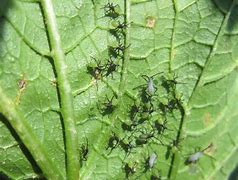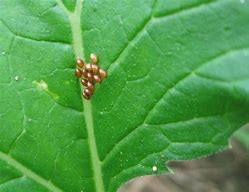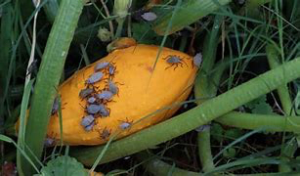The Problem
- Squash bug adults and nymphs feed primarily on squash and pumpkins, sucking plant juices and leaving the plants unhealthy and often infected with diseases.
- Squash bugs can fly — and don’t mind traveling some distance to find your plants
- it’s impossible to avoid getting squash bugs in your cucurbits without the cooperation and active involvement of your neighbors in the garden.
Identification


- Squash bugs are 5/8 of an inch long and 1/3 as wide. Adults are winged and grayish brown with a flat back.
- The nymphs, shown in the photo on the right, are wingless, spider like and often covered with a whitish powder.
- Eggs are found either on stems or the underside of leaves.

Signs of damage
- Infested leaves lose nutrients and water and become speckled, later turning yellow to brown.
- With a heavy infestation plants begin to wilt and the points of attack become black and brittle.
- It’s not always easy to tell the difference between wilt caused by a bug infestation and one caused by a bacteria or fungus. You’ll just have to look for the bugs.


Controls
- The best method for controlling squash bugs is sanitation: removing their shelters before winter sets in.
- Remove old cucurbit plants (squash, zucchini, pumpkins, melons, and cucumbers) immediately after harvest.
- Squash bugs overwinter under dead leaves, rocks, wood, and other garden debris.
- Using a trellis for vining types of squash and melons can make them less vulnerable to squash bug infestation.
- Neem oil, organic insecticides and insecticidal soaps can be used to control adults and nymphs, but these are wide-spectrum sprays and eliminate beneficial insects as well as harmful ones.
